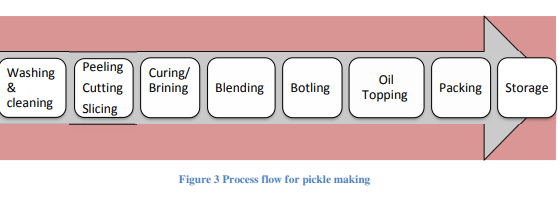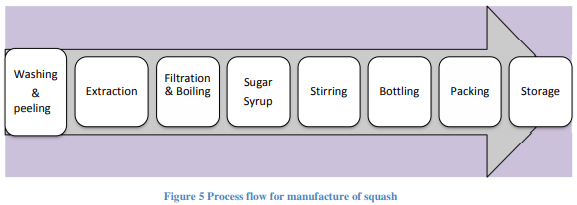NABARD Norms Fruit & Vegetable Processing Unit
Fish Production

Introduction
Introduction India is the second largest producer of fruits and vegetables in the world after China. It accounts for about 15 per cent of the world’s production of vegetables.
| Produce | Fruit | Vegetable | Spices |
| Production (MT) |
98.57 | 185.88 | 16.36 |
| Area (Mha) |
6.64 | 10.1 | 3.88 |
( Data 2018-19)
As per the latest estimates, by Central Institute of Post Harvest Engineering and Technology (CIPHET), Ludhiana, the wastage of fresh horticultural produce is upto 18 per cent due to poor postharvest management practices.
This wastage can be easily prevented by adopting various methods of preservations. There are various methods of preservation of food including thermal processing, fermentation, pickling, dehydration, freezing etc.
Products:-
Canned fruit pulp and vegetables:- Canning a method of preservation in which a cooked or uncooked food is sealed in tin plated and lacquered steel cans. The sealed cans are sterilized by heat treatment under high pressure in retort. The temperature required for effective sterilization varies with the pH of the product and is generally higher than boiling point of water (100°C or 212°F).


In fruits canning sugar syrup of desired brix is used.
In vegetables canning brine solution is used.
Pickle:- Pickling is a process of preservation by fermentation. The fruits and vegetables are immersed in 5–10 per cent salt solution (brine) leading to lactic acid fermentation. The natural sugars present in fruits and vegetables are converted to lactic acid at 25°C. The fermentation process takes a few weeks finishing at about 1 per cent acidity of final product.

Jam& jelly:- Fresh fruits contain more than 80 per cent water and 10 to 15 per cent sugars. Therefore, fruits are good food for microorganisms. The fruits spoil very fast, if not preserved in time. One of the traditional methods of preservation is conversion of fruit pulp to jam and jelly. Jam, jelly and marmalade are based on preservation by high sugar concentration. All fruits can be converted to jam by mashing or slicing it fine, adding an approximately equal amount of sugar, and simmering until it reaches proper concentration or gel at 218° to 222°F (103°–105°C).

Squash:- Squashes are sweetened juice of fruits containing minimum prescribed quantity of pulp. As per Indian Standards, squash should contain at least 25 per cent (by volume) of fruit juice. The squashes are consumed after dilution by drinking water in 1:3 ratio.

Plant and machinery:-
Fruit washing machine:- The purpose of machine is to reduce the initial microbial load by washing raw materials with chlorinated water. Water used for washing has to be replaced at an interval of 3 to 4 hours.
Sorting or inspection conveyer :- This belt conveyor can be used for cutting, inspection and sorting purpose.
Screw feeder:- The screw feeder is used for feeding of sorted and cut fruit to fruit mill. The capacity of feeding can vary from fruit to fruit.
Twin pulper:- The pulping is major activity in this project. The pulper crushes fruit and fine pulp is extracted. Therefore, a pulper of 3 MT per hour for fruits is required to ensure the regular supply of pulp.
Steam jacketed kettle :- Steam jacketed kettle is a double walled cooking vessel. Pulp / other products requiring processing are heated in steam jacketed kettle at desirable temperature to reduce microbial load.
Means of Finance
Financing to food processing falls under priority sector lending. The loans to units meeting the criteria of MSME are classified under MSME sector.
Margin money:- The margin money varies from minimum 10 per cent to 25 per cent of project cost. We have assumed margin money of 25 per cent in this model scheme.
Bank loan:-The promoters of the units can approach any financing bank for finance. It is compulsory to take bank loan to avail various subsidy schemes of government.
Interest rate:- The banks are free to charge rate of interest above its base rate within overall RBI guideline issued from time to time. considered an interest rate of 12 per cent for working out the bankability of the model project.
Financial Analysis:-
Estimated Financial Indicators
| Financial Indicator | Estimated | Requirement |
| NPW @15% DF | 43.96 | Should be +ve |
| IRR | 36.73% | More than 15% |
| BCR | 1.09 | Should be >1.0 |
| DSCR | 1.68 | Should be >1.5 |
Repayment period and debt service coverage ratio (DSCR):- The bank loan with interest is repayable within 8 years with a grace period of one year.
Q.1 fresh fruit contain how much % sugar?
- 10-15%
- 20%
- 25%
- 30-35%
- 50%
Q.2 what is margin money for Fruit & Vegetable Processing Unit model scheme according to NABARD Norms?
- 20%
- 30%
- 25%
- 35%
- none of these
Q.3 Loan for Fruit & Vegetable Processing Unit comes under which sector according to NABARD Norms?
- MSME
- Large scale indusrties devlopment
- PM-Infrastructure devlopment fund
- industrial devlopment scheme
- none of these
Q. 4 washing water of fruit in fruit washing machine should be changed in……hours ?
- 1 hours
- 2 hours
- 4 hours
- 8 hours
- 1 day
Q.5 Ratio of Squase and drinking water for consumption according to NABARD Norms?
- 1:3
- 2:5
- 2:7
- 1:1
- None of these
NABARD Norms Fruit & Vegetable Processing Unit
Good continue